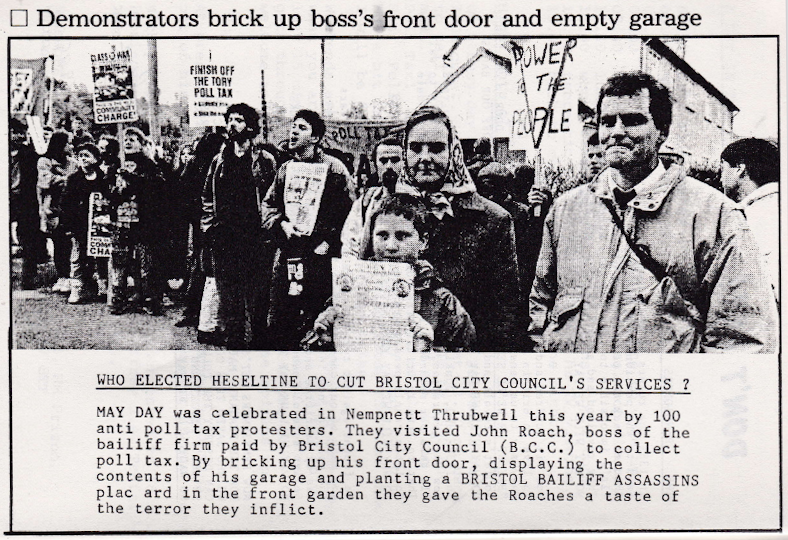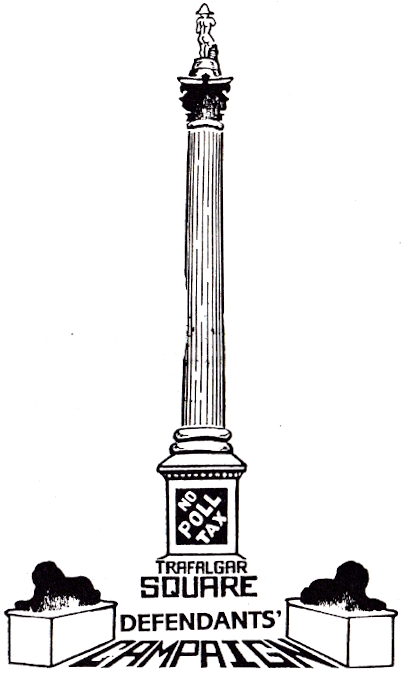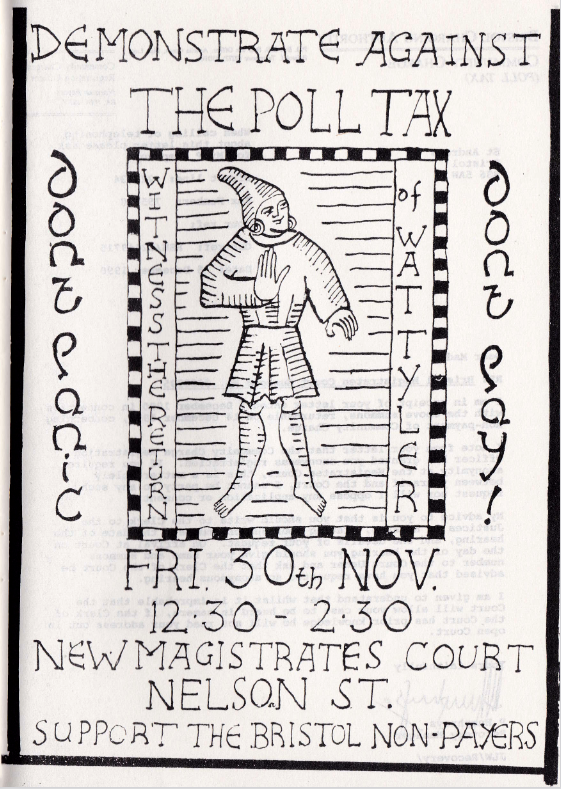Today I continue my scan through some of the material at The Sparrows’ Nest Library’s archive of Poll Tax resistance ephemera.
After the poll tax riots, the milquetoast Labour party condemned the protesters of course, and even elements within the established tax resistance group All-Britain Anti-Poll Tax Federation tried to distance themselves — Tommy Sheridan, for example, promising to rat out any rioters he could identify to the authorities.
This left the grassroots to organize support for people arrested at the protests, which they did, in the form of the Trafalgar Square Defendants’ Campaign. Among the goals and tactics of this group and its affiliates:
- Be led by and accountable to the defendants themselves (independent of established anti-poll tax organizations and parties), and support all of the defendants unconditionally (e.g. not try to weed out “bad” defendants)
- Collect and share evidence that could be useful in court (e.g. film and photographs)
- Pay travel and court costs that would otherwise discourage defendants from putting up a defense
- Educate defendants about their rights and about what to expect in court
- Find witnesses willing to give statements about what they saw at the demonstrations at which arrests were made
- Organize pickets of prisons and courthouses
- Organize legal support and education at ongoing protests, and photograph & videotape those protests to create evidence to use in defense against anticipated prosecutions
- Fight for an amnesty for poll tax refusers and prisoners
- Coordinate support for jailed or imprisoned resisters (funding their canteen accounts, encouraging letter-writing, facilitating family visits) — a distinct “Prisoners Support Group” was established to concentrate on this aspect of the work
- Advise those who were pursuing legal action against the police for false arrest, battery, and so forth
Here is an example, from the issue of Stand Firm (the TSDC newsletter). It concerns a protest and how the campaign had become much more prepared to respond legally and to get their story out in the press:
The TSDC organised a legal back-up and monitoring system to coordinate and support the marches and pickets.
Its purpose was to provide legal information before the march, legal support in case of arrests (and subsequent back-up), and most importantly, 60 volunteers to carry this out and monitor police tactics.
To do this the volunteers used still and video cameras, extensive note-taking, witness statements, and a network of communication via cell-phones, megaphones, a 48-hour coordination office, solicitors, and doctors.
Following two press conferences were held by TSDC to present a coherent and truthful account of the day’s events, in the light of the hundreds of witness statements, video film, and legal volunteer reports.
The first was held , with a large press attendance.
TSDC gave a detailed chronology of what happened, the tactics used by the police, eye-witness accounts by participants including those injured.
The second press conference presented a preliminary report and showed a video-film of the prison picket, which was subsequently shown on television news.
This new approach to the media and press did much to counter the obvious lies, propaganda, and media crap which we saw after , and put the Met. Police on the defensive.
A later issue, covering a later protest, shows that they were continuing to add to their support tactics at that stage:
[W]e did national mailouts of briefing packs, phone rounds, attending all London and national meetings (including all stewards [protest monitors] meetings) and so on.
We recruited and briefed about 150 legal volunteers to cover the march, including camera crews and a coordination office — these, along with the sixty or more contingents who had come with legal volunteers, ensured that the police were watched and the movement prepared.
Over 20,000 bust cards were distributed.
We feel that this successfully inhibited the police and helped to prevent arrests.
And:
The TSDC role on the day was to provide a full legal back-up operation in case of any problems.
This consisted of up to 300 legal observers to note arrests and monitor police activity, backed up by a fully staffed legal co-ordination centre linked by mobile phones to the observers to instantly collate and interpret incoming information from the street, and provide sympathetic solicitors and support for anyone arrested.
This involved a huge amount of pre-planning and the whole point was to ensure that never again would demonstrators be randomly arrested, dragged through the magistrates courts, and found guilty because no witnesses were found who could contradict the lies of the police.
The aim was also to subject the police to continuous surveillance in order to greatly inhibit any police violence (from individuals, groups, and the force as a whole).
In this we were successful.
The campaign also organized a “National Solidarity Conference Against Police Attacks” to share experiences and tactical wisdom among a variety of “people, groups, and movements who’ve experienced modern police methods and who’ve had to fight for their rights” including “Black struggles… Labour movement… Irish solidarity movement… Anti-Poll Tax campaign… [and the] Lesbian & Gay Community.”
The newsletters also noted international support for people imprisoned in the Poll Tax resistance struggle, including protests at the British embassies in Norway, Poland, and France (the last of which was briefly occupied by protesters).

The newsletter of the TSDC poll tax prisoners support group printed letters from imprisoned resisters and protesters, gave tips for people on how to support prisoners (along with mailing addresses for those inside), and organized protest and support. One creative tactic was mentioned in this coverage of a demonstration outside a jail where several poll tax prisoners were held:
The one and a half hour picket was pretty rowdy; we had a megaphone and we heard that a lot of prisoners could hear what was said.
There was loud shouting, banners were raised, small flyers were thrown into the prison courtyard and blew everywhere, and a big helium balloon was raised above the jail for 20 minutes with a “Free The Hostages” banner hanging from it.
Another issue reported on marches and pickets going not only to the jails but also to the homes and businesses of councillors who were administering the poll tax.


